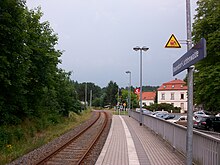Lichtenwalde (Niederwiesa)
|
Lichtenwalde
Niederwiesa municipality
Coordinates: 50 ° 53 ′ 0 ″ N , 13 ° 0 ′ 30 ″ E
|
||
|---|---|---|
| Area : | 3.1 km² | |
| Incorporation : | January 1, 1996 | |
| Postal code : | 09577 | |
| Area code : | 037206 | |
|
Location of Lichtenwalde in Saxony |
||
Lichtenwalde is a part of the municipality Niederwiesa in the district of central Saxony . It was incorporated on January 1, 1996. The landmark of the place is the Lichtenwalde Castle .
geography
Geographical location and traffic
Lichtenwalde is located on the steep west bank of the Zschopau . The Braunsdorf-Lichtenwalde stop on the Roßwein – Niederwiesa railway line is on the opposite bank of the Zschopau on Braunsdorfer Flur. In December 2004, this line was reopened by the Chemnitzer City-Bahn as a preliminary line for the Chemnitz Stadtbahn to Hainichen . The Harrasfelsen with the Harra tunnel are located north of Lichtenwalde .
Neighboring places
| Ortelsdorf | Gunnersdorf | |
| Ebersdorf |

|
Altenhain , Braunsdorf |
| Niederwiesa |
history
On the left bank of the Zschopau , 60 m above the valley, a castle was built around 1230. Its builders are the Margraves of Meißen , who colonized the entire area south and west of the river from Rochlitz a few years earlier . Initially, the castle served as a bulwark against the imperial directors Mildenstein and Schellenberg, which bordered to the north and east . It was administered by a margrave castellan , in which capacity a knight Heidenreich von Lichtenwalde acted in 1280 . Lichtenwalde Castle was owned by various noble families until 1551. Under Eustachius von Harras , the old castle was converted into a residential palace in 1550. Since he died in 1561 without a male heir, the rule of Lichtenwalde fell to the Kurhaus Sachsen , which converted the area into the lordly office of Lichtenwalde .
Around the castle, the Vorwerk , the mill and twelve small taverns were mentioned for the first time in 1339 . The foundation of these buildings certainly took place with the construction of the castle to supply the castle crew. The lordship over the Lichtenwalde estate was temporarily held by the Lichtenwalde manor or, as an administrative village, directly with the Electoral Saxon Office Lichtenwalde , which was administered from 1696 by the Electoral Saxon Office of Frankenberg-Sachsenburg and from 1783 by the Electoral Saxon or later Royal Saxon Office Augustusburg . Lichtenwalde has always been part of the Ebersdorf collegiate church . In 1551 there were 14 gardeners , 6 cottagers and 11 residents living in the village . In 1722, after the demolition of the old castle and the palace from the time of the Harras family, the baroque palace Lichtenwalde was rebuilt .
After the end of the Saxon constitution of offices in 1856, Lichtenwalde was under the jurisdiction of the Frankenberg court office and, from 1875, of the Flöha administration . In the Zschopau valley, the Braunsdorf-Lichtenwalde stop in the Braunsdorf district was opened on March 1, 1869 with the Niederwiesa - Hainichen section of the Roßwein – Niederwiesa railway line. After the baroque garden was largely opened to the population around 1870, Lichtenwalde developed into a popular excursion destination.
In July 1945 the Red Army confiscated Lichtenwalde Castle and expelled the last lady of the castle, Sibylle Countess Vitzthum von Eckstädt († 1951), who had taken in several refugee families, out of the house. While the old lady found a new place to stay with friends in the village of Lichtenwalde until her death, the castle was plundered and expropriated as part of the land reform in the Soviet occupation zone from 1945 . After the military left in 1946, the furniture and the porcelain and painting collection of the Vitzthum family were no longer available. The now nationalized castle was first used as a sanatorium from 1948, then as a TB sanatorium. In 1972 an educational institution of the GDR state health system was set up in the house.
As a result of the second district reform in the GDR , the municipality of Lichtenwalde became part of the Flöha district in the Chemnitz district (renamed the Karl-Marx-Stadt district in 1953 ), which was continued as the Saxon district of Flöha from 1990 and in 1994 in the Freiberg district, respectively In 2008 in the district of Central Saxony. On January 1, 1996 Lichtenwalde was incorporated into Niederwiesa. In 1990 the castle became the property of the re-established Free State of Saxony, which used the property as an educational center for the Saxon State Ministry for Social Affairs until 1995 . When the school moved to the newly built education center in Niederbobritzsch , the castle was initially empty, and has been used as a museum since 1999.
Attractions
- Lichtenwalde Castle with Castle Park
- Harras Monument
- Castle mill
Web links
- Lichtenwalde in the Digital Historical Directory of Saxony
- Lichtenwalde on the website of the Niederwiesa municipality
- List of cultural monuments in Niederwiesa
Individual evidence
- ^ Karlheinz Blaschke , Uwe Ulrich Jäschke : Kursächsischer Ämteratlas. Leipzig 2009, ISBN 978-3-937386-14-0 ; P. 70 f.
- ^ The Flöha district administration in the municipal register 1900
- ↑ Lichtenwalde on gov.genealogy.net






